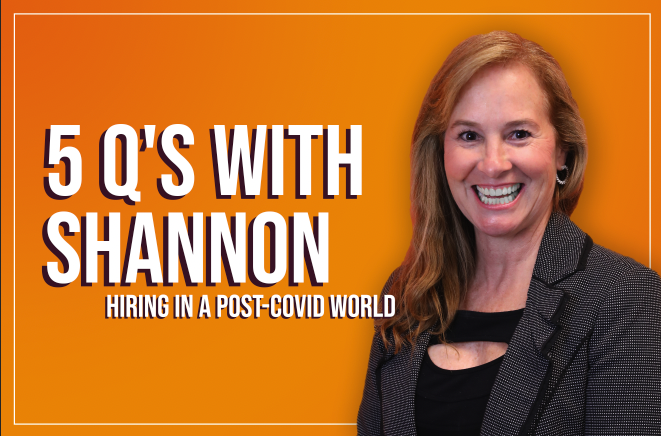
After the year we’ve just had, “Taking care of business” has an entirely new meaning now. This global pandemic has changed the way we work and probably messed with your business plans just as much as ours. A lot of businesses are growing and recovering. The 2020 wounds are stitched up and starting to heal and frankly, we’re happy to be along for the ride. Trust me, we get it. It’s also changed the way we recruit awesome talent, which is where Kinetix comes in. Check out our recent whitepaper on how to Ramp Your Recruiting in a Post-Covid World.
As the economy recovers, we figured the time was right to sit down with our own CEO, Shannon Russo, for some no-nonsense chatter about what she sees in a post-COVID world related to recruiting, retention and the candidate experience.
1. What effect do you think the change in unemployment throughout the pandemic has had on the overall candidate marketplace?
Shannon (SR): From a candidate standpoint, there was fear and stress early when there wasn’t a whole lot anyone could do. What I know is some other industries had too much to do because their business was on the other end of that spectrum and COVID increased it dramatically. It depends, but certainly there are so many small businesses, restaurants, bars and hotels that were crushed. So, as far as those businesses go, it’s been dramatic. But at the other end of the spectrum, at a significant number of companies, there was no change. We started adding people back as soon as we could and we’re on the other side of that – now we have to add new people! So, I think things are starting to come back and we feel good. I think candidates feel good. You have this mixed bag. But if it’s just unemployment, I would say that in some ways, it’s overstated.
2. With the fear and uncertainty in job security, potential candidates are staying in their current company or organization for stability. What are some ways you can make the positional opportunities and offered services stand out to attract attention?
SR: I do think you have both ends of the spectrum happening…you have people who had a really rough last year for a variety of reasons. Lots of us had that. That either makes them lean more into their company or lean back a little bit and wonder. I think if they’re leaning more in, they’re going to be harder to unseat because they’ve maybe come through a rough time and they feel good about the way their company handled it. They feel positive about where they’re going, what they’re doing and are less likely to consider something else. Then, conversely, you have people who didn’t get treated very well and they may be more open. If you’re going after some of these more passive candidates, you need to do something to get above the noise, a way you can reach out to people that isn’t typical.
3. When making a post-COVID communication strategy, what pieces work with hesitant candidates waiting out the pandemic?
SR: There’s two high level things to think about…I think some of it depends on who you’re going after. If you’re trying to get through to someone in a standard office job, I think you have to think about it differently. If you know something about a company…the more personalized you can make your messaging, the better. Just one time outreach is not going to work. The more specific you can make your message and the more you can connect with what matters to the candidate, the more effective you’re going to be. Everybody wants to feel special and if you want to get above the noise, you have to connect them to get them to listen.
4. What are some personal examples or recent stories that reflect a positive status and thriving work environment, despite the pandemic?
SR: Last year sucked. For me, it sucked. One of the messages I want to tell to our team is for us is to look at how many people we brought back. We are honest, we’re transparent, and we do what we say we’re going to do. Our ability to tell the story of how many people we have been able to bring back…if you’re willing to come back, you probably had a relatively good experience. As a company like Kinetix, referrals are your best source of hire. Everybody knows somebody and can help find good people that are a fit for your company. Double down on your employee referrals now.
5. Most companies are still having their employees work remotely. For positions that can remain remote, how would you express to candidates what the home/in-office ratio would be moving forward? How would you convince them to return to an office environment instead of being fully remote?
SR: I would say be as authentic as you can. It’s okay as a leader to tell them that you don’t know. For me to act like I know everything is untruthful. I’m not trying to say that as a leader I don’t know anything. What I’m saying is we want to be pragmatic about figuring it out and to be honest and transparent. The video stuff is amazing and allows us to work from anywhere. I think the other side of that is that “Zoom burnout” is a thing. As much as we would like to say that this all replaces face-to-face, it doesn’t. The hallway conversations, the coffee in the breakroom and things [conversations] that we never planned, those are what make a culture strong and connect people in ways that have nothing to do with their jobs. It’s hard to replicate that. We’ve got to find what that middle ground is…and what the new office environment looks like.
Now you see where we get it from, she calls like she sees it! Feel free to connect with Shannon yourself through LinkedIn.
